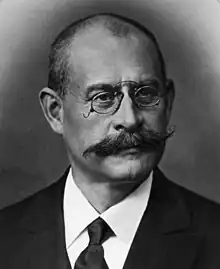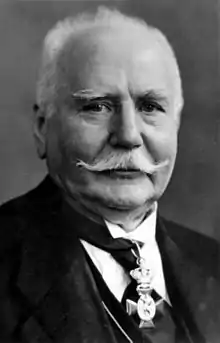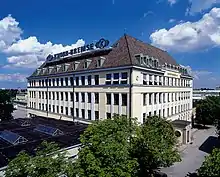Knorr-Bremse
Knorr-Bremse AG is a German manufacturer of braking systems for rail and commercial vehicles that has operated in the field for over 110 years. Other products in Group's portfolio include intelligent door systems, control components, air conditioning systems for rail vehicles, torsional vibration dampers, and transmission control systems for commercial vehicles. In 2022, the Group's workforce of over 31,000 achieved worldwide sales of EUR 7.15 billion.[2][3]
| Type | Aktiengesellschaft |
|---|---|
| FWB: KBX MDAX Component | |
| Industry | Manufacturing |
| Predecessor | Süddeutsche Bremsen-AG |
| Founded | 1905 Berlin, Germany |
| Headquarters | Munich, Germany |
Key people | Marc Llistosella, Chief Executive Officer (CEO); Dr. Reinhard Ploss, Chairman of the Supervisory Board |
| Products | braking systems (rail and road) |
| Revenue | €7.15 billion (2022)[1] |
| €506 million (2022)[1] | |
Number of employees | 31,464 (as of 31 December 2022)[1] |
| Website | www |





The Group has a presence in over 30 countries, at 100 locations.[4]
On 13 October 2022, it was announced that Knorr-Bremse AG had chosen Marc Llistosella to be a member of the Executive Board and CEO. The appointment takes effect as of 1 January 2023.[5]
History
Foundation
Engineer Georg Knorr established Knorr-Bremse GmbH in 1905 in Boxhagen-Rummelsburg, Neue Bahnhofstraße, near Berlin (since 1920 part of Berlin-Friedrichshain). Its production of railway braking systems derived from a company ("Carpenter & Schulze") founded in 1883. In 1911 the company merged with "Continentale Bremsen-GmbH" to found Knorr-Bremse Aktiengesellschaft (AG). From 1913 onwards, a second manufacturing plant, new headquarters, a heating plant and other annex buildings were erected.
The initial basis for Knorr's commercial success was provided by an agreement with the Prussian State Railways, which at that time had formed the Prussian-Hessian Railway Company, to supply single-chamber express braking systems, first for passenger and later on for freight trains. A compressed-air brake, the "Knorr Druckluft-Einkammerschnellbremse" (K1), along with its derivatives, offered considerably enhanced safety performance compared with traditional systems.
In the early twentieth century, train guards still had to operate brakes by hand, from so-called "brake vans". The first pneumatic brakes were of a basic design, but before long, indirect automatic systems using control valves were developed. See History of rail transport in Germany for an overview.
Expansion
In 1920 the manufacturing plant of the first Bayerische Motoren-Werke AG (BMW, established in 1917/1918) located in Munich, Moosacher Straße, became a subsidiary of Knorr-Bremse, delivering brake systems as Süddeutsche Bremsen-AG for the Bavarian Group Administration, the former "Royal Bavarian State Railways".
There was no further interest in motor engines for aircraft and automobiles. The engine construction and the company name "BMW" were sold in 1922 to financier Camillo Castiglioni to be combined with the Bayerische Flugzeugwerke AG (BFW, located not far away), establishing the company a second time. For details see History of BMW and BFW/Messerschmitt.
1922 until 1927 the new main manufacturing plant in Berlin at the Hirschberger Straße/Schreiberhauer Straße next to the Berlin Ringbahn was erected, a tunnelled road combined both the old and the new site.
The second main area of activity emerged in 1922, when Knorr moved into pneumatic braking systems for commercial road vehicles. The company was the first in Europe to develop a system that applied the brakes simultaneously to all four wheels of a truck as well as its trailer. The resultant reduction in braking distances made a significant contribution to improving road safety.
A small number of the Swedish light MG35/36 machine guns AKA "Knorr-Bremse machine guns" were also manufactured by Knorr-Bremse for the Wehrmacht during the Second World War.
Re-establishment
The company is relocated at the Süddeutsche Bremsen-AG plant in Munich, the former sites in the eastern part of Berlin being expropriated after 1945.
Timeline
| 1900 | Georg Knorr invents Knorr-Einkammerschnellbremse (K1) compressed-air brake for passenger trains. |
| 1905–24 | Knorr founds Knorr-Bremse GmbH near Berlin. Knorr-Bremse develops air brakes for trains and becomes a major European manufacturer of rail vehicle brakes. Bruno Kunze and Knorr invent Kunze-Knorr brake, later enhanced to Hildebrand-Knorr brake with Wilhelm Hildebrand. |
| 1911 | Georg Knorr dies during reconvalescence in Davos, Switzerland. Foundation of Knorr-Bremse Aktiengesellschaft. |
| 1918–27 | Kunze-Knorr (KK) automatic compressed-air brake equipped by the Deutsche Reichsbahn on passenger and freight trains. |
| 1920 | Former BMW plant in Munich becomes a subsidiary, manufacturing braking systems as Süddeutsche Bremsen-AG. |
| 1923 | Development of air brakes for commercial road vehicles and trailers. |
| 1931–39 | The Hildebrand-Knorr (HiK) braking system is used for express trains in 17 countries. By that time 90% of all German lorries in the 7–16 t range are fitted with Knorr braking systems. |
| 1945–53 | Company headquarters are relocated from Berlin to Munich (former Süddeutsche Bremsen-AG) in Bavaria. Development and manufacture of braking systems resumed in the western part of Germany, with emphasis on HiK system. |
| 1955 | Introduction of the Knorr-Bremse mit Einheitswirkung (KE) braking system for passenger and freight trains. |
| 1972 | Anti-lock braking system for commercial road vehicles. |
| 1985–93 | During a difficult phase in the company's development, Heinz Hermann Thiele acquires a majority share and launches a radical restructuring program. Knorr-Bremse becomes a global player. The AAR DB60 control valve for freight trains gains access to North American market. |
| 1992 | Pneumatic disc brake for commercial vehicles introduced. Series production begins in 1996. |
| 1999 | Robert Bosch GmbH merges activities in the electronic brake control sector with Knorr-Bremse Commercial Vehicle Systems. Knorr-Bremse takes a 60% share, giving it overall managerial control of the joint venture; Bosch retains a 20% share. |
| 2002 | Knorr-Bremse takes over Bendix Commercial Vehicle Systems from Honeywell International Inc., Bendix becoming a subsidiary. Knorr-Bremse Group achieves sales of EUR 2.1 billion for the first time. Modular braking system for locomotives is introduced. |
| 2004 | Oil free compressor for railway vehicles. System-compressor with coupling for road vehicles. |
| 2005 | Centenary of operation. |
| 2016 | Vossloh Electrical Systems was acquired.[6] |
Products
Rail vehicles
Knorr-Bremse not only produces complete braking systems for all types of rolling stock but also door systems, toilets, air conditioning, couplings and windscreen wipers. In 2000, it purchased British manufacturer, Westinghouse Brakes (formerly the brakes division of Westinghouse Brake and Signal Company Ltd), from Invensys, and subsequently moved its operations from Chippenham to the nearby English town of Melksham, Wiltshire.[7]
Since 2002, Knorr-Bremse has been working on variable gauge systems for more efficient solutions to break of gauge problems.
Commercial vehicles
Knorr-Bremse has been developing and manufacturing braking systems for commercial vehicles since 1920, for trucks and semi-trailer tractor units over 6 tonnes, buses, trailers or special vehicles.
References
- "Company Information". ir.knorr-bremse.com.
- "Company Information". ir.knorr-bremse.com. Retrieved 12 May 2023.
- Maudes Capital (24 September 2016). "Haldex AB Bidding War. Get It While You Can!". Seeking Alpha. Retrieved 24 September 2016.
- "Knorr-Bremse worldwide. | Knorr-Bremse Group". Retrieved 9 September 2020.
- "Marc Llistosella to Become the New Chief Executive Officer of Knorr-Bremse AG". Knorr-Bremse. 13 October 2022. Retrieved 12 May 2023.
- "Vossloh Electrical Systems sold to Knorr-Bremse", www.railwaygazette.com, 21 December 2016
- Invensys investor relations news release, 25 April 2000 Invensys Sells Westinghouse Brakes to Knorr-Bremse. Retrieved from the Internet Archive on 30 March 2008.
